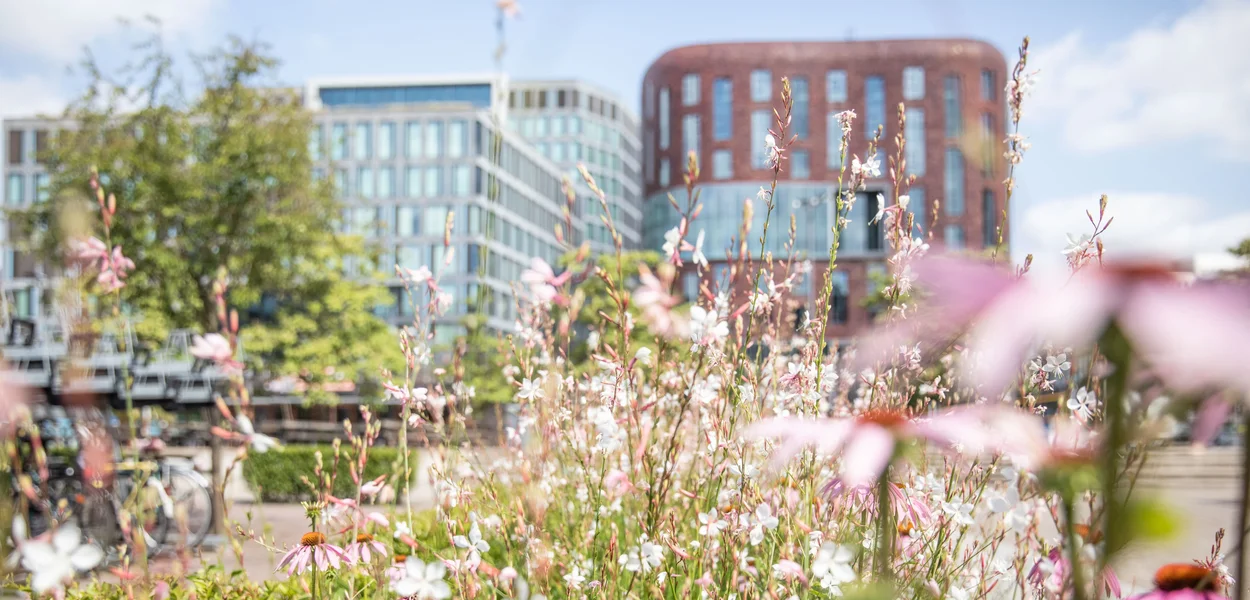Working on blue-green construction

Katinka Quintelier discusses the possibilities of blue-green construction to make cities more sustainable, through collaborative research by VU Amsterdam and the UT.
Working on blue-green construction
Katinka Quintelier is an assistant professor of Strategy and Ethics at the School of Business and Economics at VU Amsterdam. Within the impact coalition Responsible Societies, she and a team of researchers from VU Amsterdam and the UT are investigating the possibilities of blue-green (nature-inclusive) construction. "It's a huge challenge because it requires a complete system change and a focus on the long term."
"In the Netherlands and many other countries, urbanisation is increasing and much of the construction is 'dead' or grey buildings. Nature is almost absent. We are looking for ways to integrate more blue-green construction, which includes water and nature in urban areas. Due to urbanisation and the climate crisis, the water cycle is disrupted, leading to more frequent heatwaves, drought and waterlogging. We want cities to cope better with drought, waterlogging and extreme temperatures. This can be achieved by creating roofs that retain water or car parks that allow water to pass through. Additionally, we want nature, both plants and animals, to become an integral part of the city. This improves the temperature, our health and overall quality of life."
System change
This is a noble goal, but it also presents a huge challenge, as it requires a complete system change and a focus on the long term and the common good. Our current construction system isn't set up for this. The existing grey construction mainly focuses on short-term goals and self-interest, and the financing, resources and materials are aligned with that. Take blue-green roofs, for example. They are beneficial for the neighbourhood and focused on the long term because they can reduce the risk of flooding and heat stress. However, the costs currently fall solely on the property owner at the time of purchase. Therefore, the costs and benefits of blue-green construction need to be distributed differently than they are now.
Beautiful and meaningful work
Blue-green construction also requires a different mentality and a shared vision of the future. How do you get people to let their grass grow, flowers bloom and leave insects alone? How do you get the construction industry to invest in this themselves? First, like-minded individuals from different sectors need to have regular discussions, such as technicians, engineers, economists, social scientists and psychologists. What do they want and need from each other, and what is required to take the step towards blue-green construction? Our research team is working on this puzzle. It's beautiful and meaningful work, and we’re also in luck with the timing. The urgency to build a more sustainable society is growing, and a lot of houses need to be built. We also have Europe on our side. The Green Deal can help us make this significant change.
Absolute must
I think it’s wonderful to work as a social scientist with the technical colleagues from the UT. I really feel that there’s genuine interest from both sides in each other's world and expertise. This way, we complement and strengthen each other. Multidisciplinary work is an absolute must for this topic. We’re currently working on two recent projects: LILa and AUBE. LILa is the Living Innovation Lab at the UT, where blue-green buildings will be constructed. AUBE is a consortium of 23 organisations in Northern, Southern, Western, Eastern and Central Europe, spreading Adaptive Urban Building Envelopes, which are buildings that make cities adaptable to drought, heat and other extremes."
For more information about the projects and the coalition, contact Katinka Quintelier at k.j.p.quintelier@vu.nl.
How do you get the construction industry to invest in this themselves? First, like-minded individuals from different sectors need to have regular discussions.
